Maria Theresa of Spain
Maria Theresa of Spain (Spanish: María Teresa; French: Marie-Thérèse) (10 September 1638 – 30 July 1683) was the daughter of Philip IV, King of Spain and Elizabeth of France. She was Queen of France as wife of King Louis XIV. She was the mother of the Grand Dauphin. During her lifetime in Spain, she was painted by the renowned painter, Diego Velázquez.
In Spain
Early life
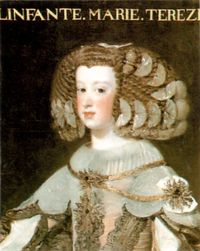
Maria Theresa as Infanta of Spain
Born as Infanta María Teresa of Spain being paternal great-great-granddaughter of an Archduke of Austria, at the Royal Monastery of El Escorial, she was the daughter of Philip IV, King of Spain and his Queen consort, Elizabeth of France. Another Spanish infanta, her paternal aunt and mother-in-law, Anne of Austria, Queen of France, also used the Austrian archducal title, then still affected by the Spanish Habsburgs, denoting the origins of the family. María Teresa thus combined the blood of Philip III of Spain and Margaret of Austria, on her father's side, and that of Henry IV of France and Marie de' Medici, on her mother's side. In his turn, Philip III was the son of Philip II of Spain and Anna of Austria who was, herself, a daughter of Maximilian II, Holy Roman Emperor and Maria of Spain. Philip II and Maria of Spain were siblings, being both children of Charles V, Holy Roman Emperor and Isabella of Portugal. María Teresa, therefore, like many Habsburgs, was a product of years and generations of royal intermarriage between cousins (to illustrate, Philip II married Anna, who was his niece; thus Maria Teresa's great-grandmother was married to her own uncle, which makes Philip III not only his mother's son but her first cousin, and Maria Teresa is both Anna's great-granddaughter and her first cousin twice removed).
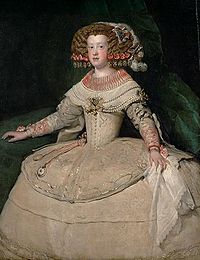
Infanta María Teresa by Velázquez, 1653. Here, she wears her hair in a popular style at the Spanish royal court, and also wears extremely wide panniers, also popular in Spain.
When Baltasar Carlos, heir to the Spanish throne, died, as a birth right, María Teresa could inherit the vast Spanish Empire and all the wealth it offered, since there was no restriction in Spanish succession law to the accession of a queen regnant (unlike in France with the Salic Law). While it has been said that she would have made a very good queen of Spain, María Teresa gained the reputation of being rather dull and simple as Queen of France.
It could be said that María Teresa had somewhat of a difficult childhood. Her mother, a beautiful French princess, died when she was just six years old. Her father loved her greatly though. He married his niece, Mariana of Austria, whose mother was his sister, a Spanish infanta. Mariana gave birth to Infanta Margarita Teresa, who was painted in by Velázquez in numerous portraits, and was the central figure in his Las Meninas. Margarita Teresa became Empress of the Holy Roman Empire, but died at the age of twenty-two.
In 1658, as the war with France began to wind down, a union between the two royal families, of Spain and of France, was proposed as a means to secure peace. María Teresa and the French king were double first-cousins, and it was proposed that they wed. His father was Louis XIII of France, who was the brother of her mother, while her father was brother to Anne of Austria, his mother. Such a prospect was intensely enticing to Anne of Austria, mother of Louis XIV and aunt of María Teresa, who desired an end to hostilities between her native country, Spain, and her adopted one, France, and who hoped this to come by her niece becoming her daughter-in-law.[1] However, Spanish hesitation and procrastination led to a scheme in which Cardinal Mazarin, the First Minister of France, pretended to seek a marriage for his master with Margaret Yolande of Savoy, the second daughter of Christine Marie of France, who was a sister of Louis XIII. When Philip IV of Spain heard of the meeting at Lyon between the Houses of France and Savoy in November 1658, he reputedly exclaimed of the Franco-Savoyard union that "it cannot be, and will not be". Philip then sent a special envoy to the French Court to open negotiations for peace and a royal marriage.
Marriage

María Teresa is handed over to the French and her husband by proxy,
Louis XIV on the Isle of Pheasants
The negotiations for the marriage contract were intense. Eager to prevent a union of the two countries or crowns, especially one in which Spain would be subservient to France, the diplomats sought to include a renunciation clause which would deprive María Teresa and her children of any rights to the Spanish succession. This was eventually done but, by the skill of Mazarin and his French diplomats, the renunciation and its validity were made conditional upon the payment of a large dowry. As it turned out, Spain, impoverished and bankrupt after decades of war, was unable to pay such a dowry, and France never received the agreed sum of 500,000 écus.[2]
After a marriage by proxy to the French king in Fuenterrabia, María Teresa became known as Marie-Thérèse. Her father, Philip IV, and the entire Spanish court accompanied the bride to the Isle of Pheasants, in the Bidassoa, where Louis and his court met her. On 7 June 1660, she departed from her native country of Spain. Like her father, the new bride knew that they were unlikely to ever see each other again during their lifetime; it was not customary for foreign princesses to revisit the land of their birth: emotional ties were to be severed. It would take an extraordinary event for her to return to Spain. Two days later, on 9 June, the religious marriage took place in Saint-Jean-de-Luz Saint Jean-Baptiste church, which had recently been rebuilt on the site of the former 13th century church burned several times in the 15th and 16th centuries.
After the marriage ceremony, Louis wanted to consummate the marriage as quickly as possible. However the new queen was granted by her mother in law (and aunt) the privilege that the consummation would be private, and not public as was the custom.
In France
Court life
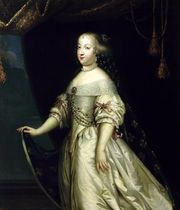
Marie-Thérèse as Queen of France
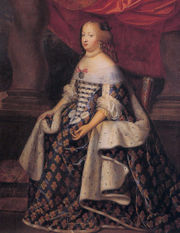
Official portrait of Marie-Thérèse as Queen of France, by Charles Beaubrun
On 26 August 1660, the newlyweds made the traditional the Royal Entry in Paris. This was to be Marie-Thérèse's introduction to her husband's subjects. She smiled and waved graciously.
Louis was faithful to his wife for the first year of their marriage, even going so far as to command the Grand Maréchal du Logis that "the Queen and himself were never to be set apart, no matter how small the house in which they might be lodging"[3]. He enjoyed the legitimate passion that his wife felt for him. However, the couple would later have difficulty in matching their personalities. While all Paris glorified the good looks of the King, Marie-Thérèse continued to put on weight with her delight in hot chocolate and to withdraw into her circle of dwarfs. It seemed Marie-Thérèse was always the last to know that her husband had found a new mistress. Despite this neglect, it is said that the King would perform his conjugal duties every night. Nonetheless, Louis' taking Louise de La Vallière as his first official mistress, caused the Queen much emotional pain. In later years, Louise would make a public apology for her wrongs against the Queen.
Marie-Thérèse, in a sense, was very lucky to have found such a friend in her mother-in-law, as many princesses in lands foreign to them would not. Marie-Thérèse continued to spend much of her free time playing cards and gambling, as she had no interest in politics or literature. Consequently, she was viewed as not fully playing the part of Queen designated to her by her marriage. However, she became pregnant in early 1661. The long awaited son was born on 1 November 1661. In Spain, five days after the birth of the dauphin, Marie-Thérèse's stepmother, Queen Mariana, gave birth to the future King Charles II of Spain, who was born with many defects due to his family's interbreeding. This set the question for the future Spanish succession, since Spain's heir was practically disabled mentally and physically.
The first time Marie-Thérèse ever saw the Palace of Versailles was on 25 October 1660. Then, it was just a small royal residence which had been Louis XIII's hunting lodge not far from Paris. Later, the first building campaign (1664–1668) commenced with the Plaisirs de l’Île enchantée of 1664, a fête that was held from 7 to 13 May 1664. The fête was ostensibly given to celebrate the two Queens of France — Anne, the Queen Mother, and Marie-Thérèse, Louis XIV’s wife. But, in reality, it honored Louis's mistress, Louise de La Vallière. The celebration of the Plaisirs de l’Île enchantée is often regarded as a prelude to the War of Devolution, which Louis waged against Spain. The first building campaign witnessed alterations in the château and gardens in order to accommodate the 600 guests invited to the celebration.

Two Queens of France:
Anne of Austria with her niece and daughter-in-law, Marie-Thérèse, holding her son
Louis
As time passed, Marie-Thérèse grew more docile and the King continued and increased his romantic adventures. She tolerated Madame de Montespan, perhaps because La Montespan's malicious wit left her lost and baffled, but Marie-Thérèse was also too pious and too adoring of her husband to openly resent the position in which she was placed by his avowed infidelities. Moreover, in spite of his blatant unfaithfulness, he ensured that she was treated with the utmost respect befitting her position as Queen and his wife and did indeed reprimand Mme de Montespan when she crossed the line. Eventually, the Queen acted with dignity and did not create scenes at Court. In return, the King left her to her own devices, with her chocolate, Spanish maids and collection of dwarfs. During this period, the religious Madame de Maintenon grew in favour and began to reign over the King's mind and affections. Rather than submitting to his advances and becoming his Maîtresse-en-titre, she encouraged the King to bestow more attention on his long-neglected wife, a gracious act which Marie-Thérèse repaid by lavishing kindness on the new favourite.
Marie-Thérèse played little part in political affairs except for the years 1667, 1672, and 1678, during which she acted as Regent while her husband was absent, away on campaigns on the frontier.
Death
During the last week of July 1683, Marie-Thérèse fell ill and, as her illness worsened, her husband ordered for the Sacraments to be kept nearby. Marie-Thérèse, Infanta of Spain and Queen of France, died a painful death on 30 July 1683, at Versailles. Upon her death, said: 'This is the first trouble which she has given me.
Her state funeral was magnificent, and Jean-Baptiste Lully's requiem was played.
Of her six children only one survived her, Louis, who died in 1711. Marie-Thérèse's grandson would eventually inherit her rights to the Spanish Throne and become King Philip V of Spain in 1700.
Quotes
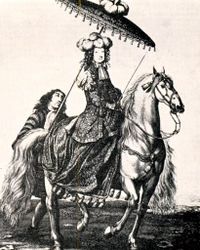
Sketch of Maria Theresa on horseback
- When asked if she found men in Spain attractive -- "How can I find other men in Spain attractive? There is no King there other than the King my father." (Comme puis-je trouver les autres hommes en Espagne attirants? Il n'y a pas d'autre Roi là-bas que le Roi mon père.)
- Upon her death -- "This is the only way in which she has displeased me." -- Louis XIV
- See the funeral oration of Bossuet, (Paris, 1684); Édouard Ducéré, Le Mariage de Louis XIV d'après les contemporains et des documents inédits, (Bayonne, 1905); Dr Cabanes, Les Morts mystérieuses de l'histoire (1900), and the literature dealing with her rivals Louise de La Vallière, Mme de Montespan and Mme de Maintenon.
- It has been suggested that she was the unnamed "great princess" who, according to Jean-Jacques Rousseau, originally said "Let them eat cake" (and not Marie Antoinette of Austria almost a century later).[4]
Issue
| Name |
Birth |
Death |
Notes |
| Maria Theresa of Spain with Louis XIV of France |
| Louis de France, Fils de France, le Grand Dauphin |
1 November 1661 |
14 April 1711 |
Dauphin of France from 1661–1711. Father of Louis de France (1682-1712), Philip V of Spain and Charles de Berry |
| Anne-Élisabeth de France |
18 November 1662 |
30 December 1662 |
Fille de France. Died in infancy. |
| Marie-Anne de France |
16 November 1664 |
26 December 1664 (?) |
Fille de France. Died in infancy or became Louise Marie-Therese (The Black Nun of Moret). |
| Marie-Thérèse de France |
2 January 1667 |
1 March 1672 |
Fille de France. Died at age five; known as Madame Royale and la Petite Madame |
| Philippe-Charles de France, duc d'Anjou |
5 August 1668 |
10 July 1671 |
Fils de France. Died at age three. |
| Louis-François de France, duc d'Anjou |
14 June 1672 |
4 November 1672 |
Fils de France. Died in infancy. |
Styles
- 1638-1660: Her Royal Highness Infanta María Teresa of Spain and Portugal
- 1660-1683: Her Majesty The Queen of France and Navarre
Ancestry
| Ancestors of Maria Theresa of Spain |
|
|
References
- ↑ Antonia Fraser. Love and Louis XIV.
- ↑ information
- ↑ Ian Dunlop. Louis XIV. London: Pimlico, 2001.
- ↑ Antonia Fraser. Marie Antoinette: The Journey. New York: Doubleday Publications, Inc., 2001.
Sources
Succession
See also
|
Queens and Empresses of France |
|
Adelaide of Aquitaine (987–996) · Rozala of Italy (996) · Bertha of Burgundy (996–1000) · Constance of Arles (1003–1031) · Matilda of Frisia (1034–1044) · Anne of Kiev (1051–1060) · Bertha of Holland (1071–1092) · Bertrade de Montfort (1092–1108) · Adelaide of Maurienne (1115–1137) · Eleanor of Aquitaine (1137–1152) · Constance of Castile (1154–1160) · Adèle of Champagne (1164–1180) · Isabelle of Hainaut (1180–1190) · Ingeborg of Denmark (1193–1193; 1200-1223) · Agnes of Merania (1196–1200) · Blanche of Castile (1223–1226) · Margaret of Provence (1234–1270) · Isabella of Aragon (1270–1271) · Maria of Brabant (1274–1285) · Joan I of Navarre (1285–1305) · Margaret of Burgundy (1314–1315) · Clementia of Hungary (1315–1316) · Joan II of Burgundy (1316–1322) · Blanche of Burgundy (1322) · Marie of Luxembourg (1322–1324) · Jeanne d'Évreux (1325–1328) · Joan the Lame (1328–1348) · Blanche of Navarre (1350) · Joan I of Auvergne (1350–1360) · Jeanne de Bourbon (1364–1378) · Isabeau of Bavaria (1385–1422) · Marie of Anjou (1422–1461) · Charlotte of Savoy (1461–1483) · Anne of Brittany (1491–1498; 1498–1514) · Joan of France (1498) · Mary of England (1514-1515) · Claude of France (1515–1524) · Eleanor of Austria (1530–1547) · Catherine de' Medici (1547–1559) · Mary, Queen of Scots (1559–1560) · Archduchess Elisabeth of Austria (1570–1574) · Louise of Lorraine (1575–1589) · Margaret of Valois (1589–1599) · Marie de' Medici (1600–1610) · Archduchess Anne of Austria (1615–1643) · Archduchess Maria Theresa of Austria (1660–1683) · Marie Leszczyńska (1725–1768) · Archduchess Maria Antonia of Austria (1774–1792) · Princess Marie Joséphine of Savoy* (1795–1810) · Joséphine de Beauharnais (1804–1810) · Archduchess Marie Louise of Austria (1810–1814) · Princess Marie Thérèse of France* (1830) · Princess Maria Amalia of Naples and Sicily (1830–1848) · Eugénie de Montijo (1853–1870)
|
|
| *disputed |
|
|
Infantas of Spain |
|
| The generations indicate descent form Charles I, under whom the crowns of Castile and Aragon were united, forming the Kingdom of Spain. Previously, the title Infanta had been largely use in the different realms. |
|
| 1st Generation |
Joan, Queen of Portugal · Maria, Holy Roman Empress
|
|
| 2nd Generation |
|
|
| 3rd Generation |
|
|
| 4th Generation |
Infanta María Margarita · Infanta Margarita María · Infanta Maria Eugenia · Infanta Isabel María · Infanta Mariana · Maria Theresa, Queen of France · Margarita Teresa, Holy Roman Empress · Infanta Maria Ambrosia
|
|
| 5th Generation |
none
|
|
| 6th Generation |
none
|
|
| 7th Generation |
Maria Anna Victoria, Queen of Portugal · Maria Teresa Rafaela, Dauphine of France · Maria Antonia Ferdinanda, Queen of Sardinia
|
|
| 8th Generation |
Infanta Maria Isabel · Infanta Maria Josefa · Infanta María Isabel Ana · Infanta Maria Josepha · Maria Luisa, Holy Roman Empress · Infanta Maria Teresa · Infanta Maria Ana
|
|
| 9th Generation |
Carlota Joaquina, Queen of Portugal · Infanta Maria Luisa · Infanta Maria Amalia Maria Louisa, Queen of Etruria · Maria Isabella, Queen of the Two Sicilies Infanta Maria Teresa
|
|
| 10th Generation |
Isabella II · Luisa Fernanda, Duchess of Montpensier · Maria Luisa, Crown Princess of Saxony* · Isabella, Countess Ignaz Gurowski* · Luisa, Duchess of Sessa* · Infanta Josefina, Mrs. José Guëll* · Infanta Maria Cristina* · Amelia Philippina, Princess Adalbert of Bavaria*
|
|
| 11th Generation |
Isabella, Princess of Asturias · Infanta Maria Cristina · Maria de la Concepcio · Maria de Pilar · Maria de la Paz, Princess Louis Ferdinand of Bavaria · Eulalia, Duchess of Galliera · Maria Isabella, Countess of Paris* · Infanta Amalia d'Orléans* · Infanta Cristina d'Orléans* · Infanta Maria de la Regla d'Orléans* · Mercedes, Queen of Spain*
|
|
| 12th Generation |
Mercedes, Princess of Asturias · Maria Teresa, Princess Ferdinand of Bavaria
|
|
| 13th Generation |
Beatriz, Princess of Citivella-Cesi · Maria Cristina, Countess of Marone · Isabel Alfonsa, Countess Jan Kanty Zamoyski* · Dolores, Princess Augustyn Józef Czartoryski* · Mercedes, Countess of Barcelona* · Esperanza, Princess Pedro Gastão of Orléans-Braganza* · Mercedes, Princess Bagration of Mukhrani* · Infanta Pilar of Bavaria*
|
|
| 14th Generation |
Pilar, Duchess of Badajoz · Margarita, Duchess of Hernani and Soria
|
|
| 15th Generation |
Elena, Duchess of Lugo · Cristina, Duchess of Palma de Mallorca
|
|
| 16th Generation |
Infanta Leonor · Infanta Sofía
|
|
| *title granted by Royal Decree |
|
|
Austrian archduchesses by birth |
|
| 1st Generation |
none
|
|
| 2nd Generation |
Archduchess Helena · Kunigunde, Duchess of Bavaria
|
|
| 3rd Generation |
Margaret, Duchess of Savoy
|
|
| 4th Generation |
Eleanor, Queen of France* · Isabella, Queen of Denmark and Norway* · Maria, Queen of Hungary* · Catherine, Queen of Portugal*
|
|
| 5th Generation |
Elisabeth, Queen of Poland · Maria, Holy Roman Empress* · Anna, Duchess of Bavaria · Archduchess Isabella* · Maria, Duchess of Jülich-Cleves-Berg · Archduchess Magdalena · Catherine, Queen of Poland · Eleanor, Duchess of Mantua · Archduchess Margaret · Joan, Princess of Portugal* · Barbara, Duchess of Ferrara · Archduchess Ursula · Archduchess Helena · Joanna, Grand Duchess of Tuscany
|
|
| 6th Generation |
Anna, Queen of Spain · Elisabeth, Queen of France · Archduchess Maria · Archduchess Maria · Isabella Clara Eugenia, Co-sovereign of the Habsburg Hetherlands* · Archduchess Margaret · Catherine Michelle, Duchess of Savoy* · Archduchess Eleanor · Archduchess Maria* · Archduchess Martha · Archduchess Anna Eleanor · Archduchess Maria · Anna, Holy Roman Empress · Anna, Queen of Poland · Maria Christina, Princess of Transilvania · Archduchess Catherine Renata · Archduchess Elisabeth · Archduchess Gregoria Maximiliana · Archduchess Eleanor · Margaret, Queen of Spain · Constance, Queen of Poland · Maria Maddalena, Grand Duchess of Tuscany
|
|
| 7th Generation |
Archduchess Christine · Anna, Queen of France* · Archduchess Maria · Maria Anna, Holy Roman Empress* · Archduchess Anna Mauritia · Maria Anna, Electress of Bavaria · Archduchess Margarita Francisca* · Cecilia Renata, Queen of Poland · Archduchess Maria Eleanor · Isabella Clara, Duchess of Mantua · Maria Leopoldine, Holy Roman Empress
|
|
| 8th Generation |
Archduchess Maria Margarita* · Archduchess Margarita Maria Catalina* · Archduchess Maria Eugenia* · Archduchess Isabella Maria Teresa* · Maria Anna, Queen of Spain · Archduchess Maria Anna Antonia* · Maria Theresa, Queen of France* · Archduchess Maria · Margarita Teresa, Holy Roman Empress* · Archduchess Theresia Maria Josepha · Eleanor, Queen of Poland, Duchess of Lorraine · Claudia Felicitas, Holy Roman Empress · Maria Anna Josepha, Electoral Princess of the Palatinate · Archduchess Maria Ambrosia de la Concepción* · Archduchess Maria Magdalena
|
|
| 9th Generation |
Maria Antonia, Electress of Bavaria · Archduchess Maria Anna Antonia · Archduchess Anna Maria · Archduchess Maria Josepha · Archduchess Christina · Archduchess Maria Elisabeth · Maria Anna, Queen of Portugal · Archduchess Maria Theresa · Archduchess Maria Josepha · Archduchess Maria Magdalena · Archduchess Maria Margaretha
|
|
| 10th Generation |
Maria Josepha, Queen of Poland · Maria Amalia, Holy Roman Empress · Maria Theresa · Maria Anna, Princess Charles Alexander of Lorraine · Archduchess Maria Amalia
|
|
| 11th Generation |
Archduchess Maria Elisabeth** · Archduchess Maria Anna** · Archduchess Maria Carolina** · Maria Christina, Duchess of Teschen** · Archduchess Maria Elisabeth** · Maria Amalia, Duchess of Parma** · Archduchess Maria Carolina** · Archduchess Johanna** · Archduchess Maria Josepha** · Maria Carolina, Queen of Naples** · Marie Antonia, Queen of France**
|
|
| 12th Generation |
Archduchess Maria Theresa · Archduchess Marie Christine · Maria Theresia, Queen of Saxony** · Archduchess Maria Anna** · Maria Theresa, Queen of Sardinia*** · Archduchess Maria Josepha*** · Maria Leopoldine, Electress of Bavaria*** · Maria Clementina, Duchess of Calabria** · Archduchess Maria Amalia** · Archduchess Maria Antonia*** · Maria Ludovika, Empress of Austria***
|
|
| 13th Generation |
Archduchess Ludovika Elisabeth · Marie Louise, Empress of the French · Archduchess Carolina Ferdinande** · Archduchess Maria Caroline · Archduchess Caroline Ludovika · Maria Leopoldina, Empress of Brazil · Clementina, Princess of Salerno · Archduchess Maria Luisa** · Archduchess Alexandrine · Maria Theresa, Queen of Sardinia** · Marie Caroline, Crown Princess of Saxony · Archduchess Maria Anna · Archduchess Amalia Theresa · Maria Theresa, Queen of the Two Sicilies · Maria Theresa, Countess of Chambord*** · Archduchess Hermine · Archduchess Franziska · Archduchess Maria Caroline · Adelaide, Queen of Sardinia · Maria Beatrix, Countess of Montizón*** · Archduchess Maria Caroline · Archduchess Elisabeth Franziska · Marie Henriette, Queen of the Belgians
|
|
| 14th Generation |
Archduchess Maria Anna · Archduchess Maria Carolina** · Auguste Ferdinande, Princess Luitpold of Bavaria** · Archduchess Maria Maximiliana** · Maria Isabella, Countess of Trapani** · Archduchess Maria Theresia** · Archduchess Maria Cristina** · Archduchess Maria Anna** · Maria Theresa, Duchess Philipp of Württemberg · Archduchess Mathilda · Maria Christina, Queen of Spain · Archduchess Maria Eleonora · Archduchess Elisabeth · Maria Dorothea, Duchess of Orléans · Margaretha Klementine, Princess of Thurn and Taxis · Archduchess Elisabeth Henriette · Archduchess Klotilde · Maria Theresa, Queen of Bavaria***
|
|
| 15th Generation |
Archduchess Sophie · Gisela, Princess Leopold of Bavaria · Archduchess Marie Valerie · Margarete Sophie, Duchess of Württemberg · Archduchess Maria Annunziata · Elisabeth, Princess Aloys of Liechtenstein · Archduchess Maria Antonietta** · Luise, Crown Princess of Saxony** · Anna, Princess of Hohenlohe-Bartenstein** · Archduchess Margareta** · Archduchess Germana** · Archduchess Agnes** · Archduchess Maria Theresa** · Karoline Marie, Princess Leopold of Saxe-Coburg and Gotha** · Archduchess Maria Antonietta** · Maria Immaculata, Duchess of Württemberg** · Archduchess Henriette** · Maria Christina, Princess Emmanuel of Salm-Salm · Maria Anna, Princess Elias of Bourbon Parma · Maria Henrietta, Princess of Hohenlohe-Waldenburg-Schillingsfürst · Archduchess Natalie · Archduchess Stephanie · Archduchess Gabrielle · Isabella, Princess Georg of Bavaria · Alice, Baroness Waldbott of Bassenheim · Archduchess Eleonora, Mrs. Alfons von Kloss · Renata, Princess Hieronymus Radziwill · Mechthildis, Princess Olgierd Czartoryski · Archduchess Gisele · Archduchess Sophie · Archduchess Magdalena
|
|
| 16th Generation |
Elisabeth Marie, Princess of Windisch-Graetz · Helena, Duchess Philipp of Württemberg** · Rosa, Duchess of Württemberg** · Archduchess Dolores** · Maria Inmaculada, Nobile Inigo Neri Sereneri** · Margarita, Marchioness Taliani di Marchio** · Princess Maria Antonia, Mrs. Luis Pérez** · Archduchess Assunta, Mrs. Joseph Hopfinger** · Elisabeth, Countess of Waldburg-Zeil** · Hedwig, Countess of Stolberg-Stolberg** · Gertrud, Countess of Waldburg-Zeil-Trauchburg** · Archduchess Maria Elisabeth** · Archduchess Agnes** · Archduchess Margarethe, Mrs. Alexander Cech · Ilona, Duchess of Mecklenburg · Archduchess Anna Theresia · Archduchess Maria Kynga, Mrs. Joachim Krist
|
|
| 17th Generation |
Archduchess Adelheid · Charlotte, Duchess of Mecklenburg · Elisabeth, Princess Heinrich of Liechtenstein · Elisabeth, Edle Hubert von Braun** · Alice, Baroness Vittorio Manno** · Marie Antoinette, Baroness of Proff in Irnich** · Archduchess Marie Christine** · Archduchess Walburga, Mrs. Carlos Tasso** · Archduchess Verena** · Archduchess Katharina, Mrs. Roland Huber** · Agnes, Baroness Peter of Fürstenberg** · Maria Ileana, Countess Adam Kottulinski** · Alexandra, Baroness Viktor of Baillou** · Maria Magdalena, Baroness of Holzhausen** · Archduchess Elisabeth, Mrs. Friedrich Sandhofer** · Agnes, Princess Karl Alfred of Liechtenstein** · Archduchess Maria Margaretha** · Archduchess Ludovica** · Archduchess Allix** · Josepha, Countess Clemens of Waldstein-Wartenberg** · Valerie, Margravine of Baden** · Alberta, Baroness Alexander of Kottwitz-Erdödy** · Theresa, Princess Rasso of Bavaria** · Maria Inmakulata, Countess Reinhart of Hoensbroech** · Archduchess Monika, Mrs. Charles de Rambures · Archduchess Marie Christine, Mrs. Raymond van der Meide · Archduchess Maria, Mrs. Wilhelm de Witt · Margherita, Countess Benedikt of Piatti
|
|
| 18th Generation |
Andrea, Hereditary Countess of Neipperg · Monika, Duchess of Maqueda · Michaela, Countess Hubertus of Kageneck · Archduchess Gabriela, Mrs. Christian Meister · Walburga, Countess Archibald Douglas · Maria Beatrix, Countess Riprand of Arco-Zinneberg*** · Isabella, Countess Andrea Czarnocki-Lucheschi*** · Maria del Pilar, Edle Vollrad-Joachim von Poschinger · Kinga, Baroness Wolfgang of Erffa · Archduchess Marie Adelheid, Mrs. Jaime Corcuerra · Archduchess Viridis, Mrs. Karl Dunning-Gribble · Archduchess Alexandra, Mrs. Héctor Riesle · Maria Constanza, Princess of Auersperg-Trautson · Maria Anna, Princess Peter Galitzine · Catharina, Countess Maximiliano Secco d'Aragona · Archduchess Elisabeth, Mrs. James Litchfield · Sophie, Princess of Windisch-Grätz · Archduchess Marie Christine, Mrs. Clemens Guggenberg · Archduchess Marie Bernadette, Mrs. Rupert Wolff** · Archduchess Katharina, Mrs. Niall Brooks** · Archduchess Alicia** · Archduchess Maria Christina** · Archduchess Margaretha, Mrs. Andreas Baumgartner** · Archduchess Marie Valerie, Mrs. Martin Josef Wagner** · Archduchess Hedwig** · Archduchess Veronika** · Archduchess Johanna · Archduchess Elisabeth · Archduchess Celina · Archduchess Maria Floriana · Archduchess Sofía · Archduchess Anna Carolina · Archduchess Theresa · Archduchess Sophie · Archduchess Ladislaya
|
|
| 19th Generation |
Archduchess Eleonore · Archduchess Gloria · Archduchess Sophie · Archduchess Hilda · Archduchess Maria Laura*** · Archduchess Luisa Maria*** · Archduchess Laetitia Maria*** · Archduchess Sophia · Archduchess Maria Theresa · Archduchess Margherite · Archduchess Priscilla · Archduchess Marie des Neiges · Marie Christine, Countess Rodolphe of Limburg-Stirum · Archduchess Gabriella · Archduchess Antonia · Archduchess Isabelle · Archduchess Carlotta · Archduchess Paulina · Archduchess Lara · Archduchess Tatyana** · Archduchess Anabella** · Archduchess Tara**
|
|
| 20th Generation |
Archduchess Zita · Archduchess Anežka
|
|
*also an infanta of Spain
**also a princess of Tuscany
***also a princess of Modena |
|
|
Infantas of Portugal |
|
| The generations indicate descent form Afonso I, and continues through the House of Aviz, the House of Bourbon through Isabella of Portugal, and the House of Braganza through Infanta Catherine, Duchess of Braganza. |
|
|
1st Generation
|
Infanta Mafalda • Infanta Urraca, Queen of Léon • Teresa, Countess of Flanders and Duchess of Burgundy
|
|
|
2nd Generation
|
Teresa, Queen of Léon • Sancha, Lady of Alenquer • Infanta Constança • Branca, Lady of Guadalajara • Berengária, Queen of Denmark • Mafalda, Queen of Castile
|
|
|
3rd Generation
|
Leonor, Queen of Denmark • Infanta Maria
|
|
|
4th Generation
|
Branca, Viscountess of Huelgas • Infanta Sancha • Infanta Maria • Infanta Constança • Eleanor, Princess of Dacia
|
|
|
5th Generation
|
Constance, Queen of Castile and León • Maria, Lady of Menezes and Orduña • Isabel, Lady of Penela • Infanta Constança • Beatriz, Lady of Lemos
|
|
|
6th Generation
|
Maria, Queen of Castile and León • Infanta Isabel • Leonor, Queen of Aragon
|
|
|
7th Generation
|
Maria, Marchioness of Tortosa • Beatriz, Countess of Alburquerque
|
|
|
8th Generation
|
Beatriz I • Infanta Branca • Isabel, Duchess of Burgundy • Infanta Branca
|
|
|
9th Generation
|
Isabel, Queen of Castile and León • Beatriz, Duchess of Viseu • Infanta Filipa • Isabel, Queen of Portugal • Filipa, Lady of Almada • Infanta Maria • Leonor, Holy Roman Empress • Beatriz, Lady of Ravenstein • Infanta Catarina • Infanta Filipa • Joana, Queen of Castile and León
|
|
|
10th Generation
|
Leonor, Queen of Portugal and the Algarve • Isabel, Duchess of Braganza • Infanta Catarina • Saint Joana, Princess of Portugal
|
|
|
11th Generation
|
Isabel, Holy Roman Empress • Beatriz, Duchess of Savoy • Infanta Maria • Maria, Duchess of Viseu
|
|
|
12th Generation
|
Maria Manuela, Princess of Portugal • Infanta Isabel • Infanta Beatriz • Infanta Luisa • Maria, Hereditary Princess of Parma • Catarina, Duchess of Braganza
|
|
|
13th Generation
|
|
|
|
14th Generation
|
|
|
|
15th Generation
|
Infanta Maria Margarita* • Infanta Margarita Maria Catalina* • Infanta Maria Eugenia* • Infanta Isabel Maria Teresa* • Infanta Maria Anna Antonia* • Maria Theresa, Queen of France* Joana, Princess of Beira • Catarina, Queen of England, Scotland and Ireland
|
|
|
16th Generation
|
Isabel Luísa, Princess of Beira • Infanta Francisca Xaviera • Infanta Teresa Maria • Infanta Francisca Josefa
|
|
|
17th Generation
|
Barbara, Queen of Spain
|
|
|
18th Generation
|
Maria I • Infanta Mariana Francisca • Infanta Doroteia • Benedita, Princess of Brazil
|
|
|
19th Generation
|
Infanta Maria Isabel • Mariana Vitória, Infanta of Spain • Infanta Maria Clementina
|
|
|
20th Generation
|
Teresa, Princess of Beira • Maria Isabel, Queen of Spain • Maria Francisca, Countess of Molina • Infanta Isabel Maria • Infanta Maria da Assunção • Ana de Jesus Maria, Marchioness of Loulé Infanta Maria Carlota*
|
|
|
21st Generation
|
Maria II • Januária Maria, Princess Imperial of Brazil** • Infanta Paula Mariana** • Infanta Francisca** • Infanta Maria Amélia** • Maria das Neves, Duchess of San Jaime • Maria Teresa, Archduchess of Austria • Maria Josepha, Duchess in Bavaria • Adelgundes, Duchess of Guimarães • Maria Ana, Grand Duchess of Luxembourg • Maria Antónia, Duchess of Parma
|
|
|
22nd Generation
|
Infanta Maria*** • Maria Ana, Crown Princess of Saxony*** • Antónia, Princess of Hohenzollern*** • Isabel, Princess Imperial of Brazil** • Infanta Maria da Glória*** • Leopoldina, Princess Ludwig August of Saxe-Coburg-Kohary** • Maria Teresa, Princess Karl Ludwig of Thurn und Taxis • Isabel Maria, Princess of Thurn und Taxis • Infanta Maria Benedita • Infanta Mafalda • Maria Anna, Hereditary Princess of Thurn und Taxis • Infanta Filippa Maria • Maria Antónia, Mrs. Chanler • Maria Adelaide, Mrs. van Uden
|
|
|
23rd Generation
|
none
|
|
|
24th Generation
|
Infanta Maria Ana*** • Infanta Maria Francisca
|
|
|
*also an infanta of Spain
**also an imperial princess of Brazil
***also a princess of Saxe-Coburg and Gotha, Duchess in Saxony
|
|
| Persondata |
| Name |
Maria Theresa Of Spain |
| Alternative names |
|
| Short description |
|
| Date of birth |
10 September 1638 |
| Place of birth |
El Escorial, Spain |
| Date of death |
30 July 1683 |
| Place of death |
Versailles, France |
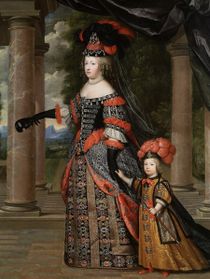






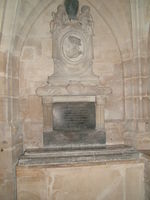

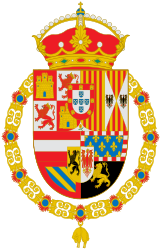
 This article incorporates text from a publication now in the public domain: Chisholm, Hugh, ed (1911). Encyclopædia Britannica (Eleventh ed.). Cambridge University Press.
This article incorporates text from a publication now in the public domain: Chisholm, Hugh, ed (1911). Encyclopædia Britannica (Eleventh ed.). Cambridge University Press.